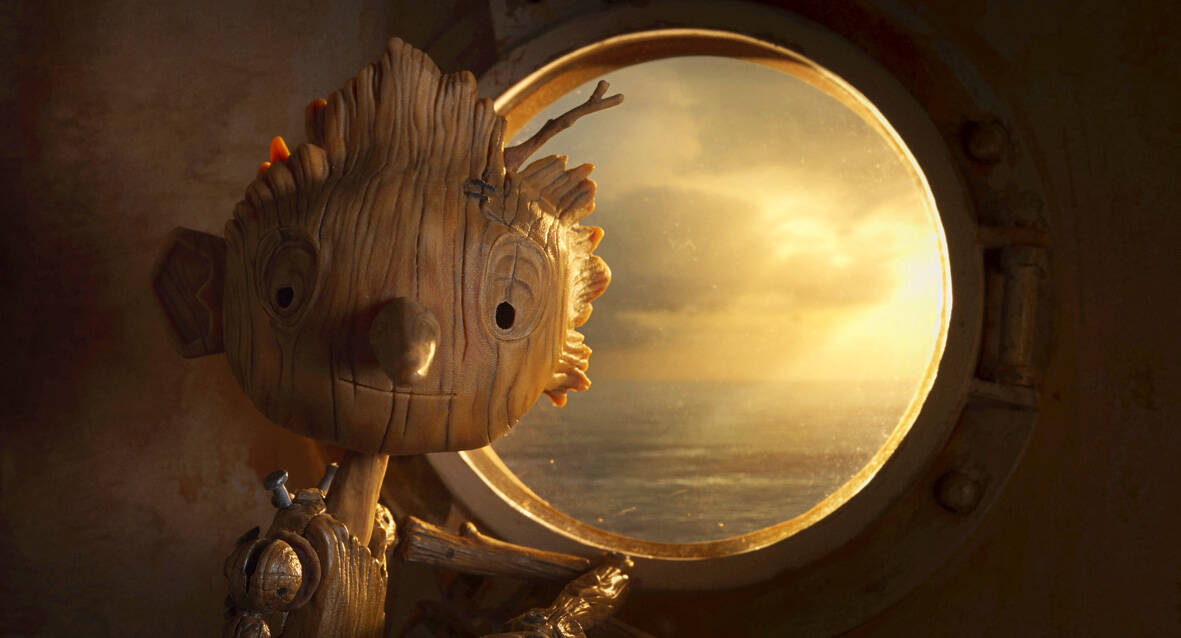Death and fascism may not seem ideal subjects for a life-affirming fantasy animation for grownup children of all ages. Yet Mexican maestro Guillermo del Toro, whose 2017 masterpiece The Shape of Water won the Oscar for best picture, brings his monstrous cinematic skills to bear on Carlo Collodi’s timeless fable with miraculous results, turning it into a Mussolini-era parable about a “lethal form of control and paternity.”
Using the tactility of stop-motion animation to lend splintery weight (both physical and emotional) to the story, Del Toro and co-director Mark Gustafson, whose credits include Fantastic Mr Fox (2009), conjure a tale of war and childhood that nods its wooden head towards Mary Shelley while thematically sitting alongside Del Toro’s Spanish-language masterpieces The Devil’s Backbone (2001) and Pan’s Labyrinth (2006).
Along with co-writer Patrick McHale (Matthew Robbins gets a “screen story” credit), Del Toro resituates Collodi’s source in the between-the-war years of the 20th century. Carpenter Geppetto (voiced by David Bradley) has lost his beloved son, Carlo, in the Great War. One night, drunk on grief, he cuts down the tree by Carlo’s grave and builds a ramshackle puppet (Gris Grimly’s illustrations provide structural inspiration) to replace his lost child. When a blue spirit breathes life into the puppet, Geppetto is initially terrified of the whirling dervish unleashed in his home. But the pair soon settle down, with Pinocchio (Gregory Mann) helping Geppetto repair the huge crucified Christ that hangs like a tortured marionette in the church where congregants shriek about demonic puppets. “Everybody likes him,” says Pinocchio, pointing up at what looks like a prop from Ken Russell’s The Devils (1971). “He’s made of wood too. Why do they like him and not me?”

Photo: AP
This is just one of many profoundly philosophical questions (another is: “How can Mussolini’s fascists use an unkillable wooden soldier as a weapon?”) that Del Toro’s Pinocchio is not afraid to raise. While previous film adaptations, from Disney’s still strange 1940 cartoon to Robert Zemeckis’s ghastly 2022 live-action reboot, have prioritized a populist litany of instructional morals (honour your father, do not tell lies, do not be lazy), Del Toro’s version celebrates its antihero’s agent-of-chaos nature, using his adventures to investigate matters of life and death with equal vigor.
Yes, Pinocchio is bequeathed a conscience in the form of a talking cricket, a character who (let us not forget) Pinocchio killed with a hammer early on in Collodi’s original. But Ewan McGregor’s narrator Sebastian J Cricket is no pious stooge; nor is the Fairy with the Turquoise Hair (whom Collodi also declares dead) a beneficent bestower of “real boy” human status. Instead, she is a multi-eyed Wood Sprite (Tilda Swinton) with one foot in the grave, whose underworld alter ego tells Pinocchio that the only path to life is (guess what?) death — the very thing that gives life value.
While it’s tempting to compare this version of Pinocchio with Matteo Garrone’s 2019 labour of love, there’s a closer bond with Steven Spielberg’s still underrated 2001 sci-fi fantasy AI: Artificial Intelligence. Like Spielberg, Del Toro is fascinated by the Frankenstein elements of a story in which monsters are not what they seem, and the attainment of “humanity” is portrayed as a flawed venture that must be solved through narrative poetry rather than physical transformation. Both directors also embrace the surreal visual spectacle of a story that sends its characters into the belly of the beast via grotesquely gaping jaws, with Del Toro also cheekily tipping his hat towards Spielberg’s most explosive creature feature.
While puppets creative supervisor Georgina Hayns looked to the “realism with an abstract brush stroke” of Norman Rockwell and Andrew Wyeth, cinematographer Frank Passingham, whose credits include Aardman’s Chicken Run (2000) and Laika studio’s 2016 feature Kubo and the Two Strings, directed his crew to The Godfather (1972) and The Godfather Part II (1974) for lighting references. With a vulpine Christoph Waltz and a freaky-monkey Cate Blanchett joining Ron Perlman, John Turturro and Finn Wolfhard in the voice cast, and Alexandre Desplat on composer duties (Del Toro co-wrote song lyrics for earworm heartbreakers such as the Oscar-tipped Ciao Papa), this is starry fare indeed. Yet ultimately, it’s the film’s sheer strangeness — that peculiarly magical, lapsed-Catholic sensibility that runs throughout all of Del Toro’s most personal works — that makes this sing and fly.

A jumbo operation is moving 20 elephants across the breadth of India to the mammoth private zoo set up by the son of Asia’s richest man, adjoining a sprawling oil refinery. The elephants have been “freed from the exploitative logging industry,” according to the Vantara Animal Rescue Centre, run by Anant Ambani, son of the billionaire head of Reliance Industries Mukesh Ambani, a close ally of Prime Minister Narendra Modi. The sheer scale of the self-declared “world’s biggest wild animal rescue center” has raised eyebrows — including more than 50 bears, 160 tigers, 200 lions, 250 leopards and 900 crocodiles, according to

They were four years old, 15 or only seven months when they were sent to Auschwitz-Birkenau, Bergen-Belsen, Buchenwald and Ravensbruck. Some were born there. Somehow they survived, began their lives again and had children, grandchildren and even great grandchildren themselves. Now in the evening of their lives, some 40 survivors of the Nazi camps tell their story as the world marks the 80th anniversary of the liberation of Auschwitz-Birkenau, the most notorious of the death camps. In 15 countries, from Israel to Poland, Russia to Argentina, Canada to South Africa, they spoke of victory over absolute evil. Some spoke publicly for the first
Due to the Lunar New Year holiday, from Sunday, Jan. 26, through Sunday, Feb. 2, there will be no Features pages. The paper returns to its usual format on Monday, Feb. 3, when Features will also be resumed. Kung Hsi Fa Tsai!

When 17-year-old Lin Shih (林石) crossed the Taiwan Strait in 1746 with a group of settlers, he could hardly have known the magnitude of wealth and influence his family would later amass on the island, or that one day tourists would be walking through the home of his descendants in central Taiwan. He might also have been surprised to see the family home located in Wufeng District (霧峰) of Taichung, as Lin initially settled further north in what is now Dali District (大里). However, after the Qing executed him for his alleged participation in the Lin Shuang-Wen Rebellion (林爽文事件), his grandsons were